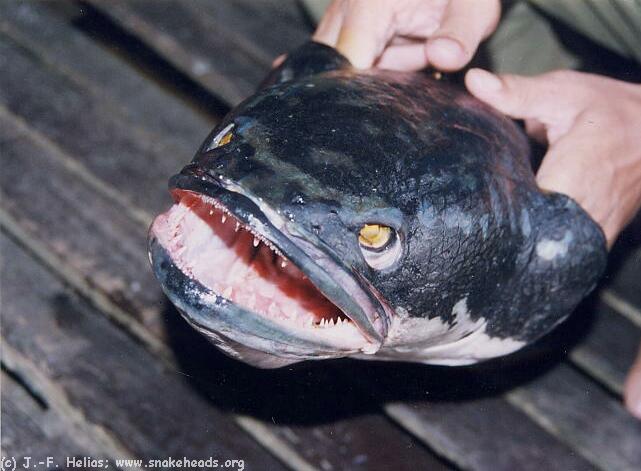
Family : Channidae
Genus : Channa
Size : up to a metre in the wild
Temperament : Very aggressive/predacious
Distribution : Asia & South East Asia
common food fish in parts of Asia and a very fierce predator in the wild. It's known as snakehead due to the resemblance of its head to a snake. Snakeheads are freshwater fish from the genus Channa. The more popularly known species are the Toman (Giant snakehead) and the Haruan (Common snakehead). Both are considered food fish and can be bought from wet markets.
Juveniles swim in schools, but adults are solitary or occur in pairs. They build bubble nests, and are the top predators in many freshwater lakes in the region. They feed on almost anything - smaller fish, frogs, baby turtles and even baby ducks. The snakehead is tolerant of anaerobic conditions because it is endowed with an air breathing apparatus. Their air breathing capabilities allow them to 'walk' on land from one body of water to another by lateral undulations of their body. The fish can live in waters having pH values of 4 to 9 and can survive the drought season in low oxygen content muddy waters. The snakeheads settle in the mud of drying bodies of water and continue to burrow deeper as the drying continues. Here the fish can survive without water for several months in a torbid state, subsisting on atmospheric oxygen and stored fat until the rain returns.Here's a brief summary of the two most common Asian snakeheads.
 | C. micropeltes of 7.2 kgs weight. How many fishes will it have digested to get this weight? |
| Common Name(s) | Giant snakehead, red snakehead, Toman |
| Scientific Name | Channa micropeltes |
| Habitat | It inhabits rivers, canals, lakes, ponds, swamps, marshes, paddi fields, mining pools and road side ditches. It becomes the top predator in these waters. |
| Water | 6.0-7.2 |
| Temperature | 73 - 80 °F |
| Size | up to 1 metres / 36 inches. |
| Diet | Live food, beef heart, worms, meaty foods |
| Breeding | Channas are nest-brooding species. The nest is prepared by the parent fish who bite off the aquatic vegetation over a roundish area in shallow water near the shore. The snakehead can breed when it is 9 months old, at a total length of about 21 cm. After the eggs are laid, they float and form a thin film at the surface. Generally, the male parent guards the nest during the incubation period which lasts 3 days. |
| Attitude | Aggressive. Best kept with larger or similar size fishes. |
| Description | The Toman is the largest of all Snakehead species in the world. They can grow to a length of about 1 metres and is an extremely tough and hardy predator. It is also considered to be one of the best fighting fresh water fish by local anglers. This quality, coupled with its good tasting flesh, makes the Toman one of the most sought after game fish in Singapore and Malaysia. |
 | C. striatus is a widespread predator. He is to find on the Phillipinnes and even on Hawaii (introduced). In the 50s this species was even introduced to Fiji, where he thanks God could not spread to disbalance its aquatic fauna. |
| Common Name(s) | Common snakehead, stripped snakehead, Haruan |
| Scientific Name | Channa striata |
| Habitat | It inhabits rivers, canals, lakes, ponds, swamps, marshes, paddi fields, mining pools and even damps. |
| Water | 5.5-7.5 |
| Temperature | 71 - 82 °F |
| Size | up to 45 centimetres / 18 inches. |
| Diet | Live food like small fishes. A natural predator in its habitat. |
| Attitude | Aggressive. Best kept with larger or similar size fishes. |
| Description | Unlike its cousin the Toman, the Haruan is an indigenous species. Adults are smaller than Tomans and can reach lengths of about 45 centimetre. Common in forested and rural streams as well as canals and reservoirs, the Aruan is often seen sold in markets. The local Chinese community, considered its flesh to posses certain medicinal values which are supposedly good for the healing of wounds. |
This article was originally published online on FishCorner
© 2001 - 2002 snakeheads.org